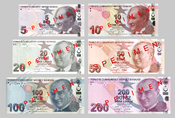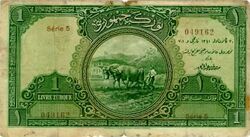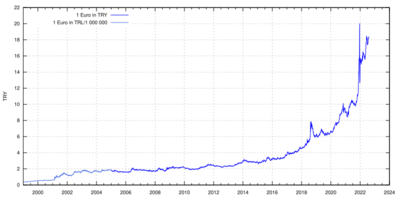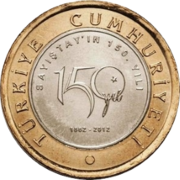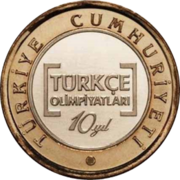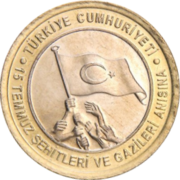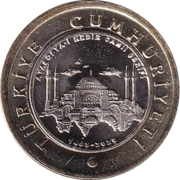Turkish lira
Topic: Finance
 From HandWiki - Reading time: 15 min
From HandWiki - Reading time: 15 min
| Türk lirası (Turkish) TL | |||||
|---|---|---|---|---|---|
| |||||
| ISO 4217 | |||||
| Code | TRY (numeric: 949) (before 2006: TRL) | ||||
| Subunit | 0.01 | ||||
| Unit | |||||
| Unit | Lira | ||||
| Plural | liralar[a] | ||||
| Symbol | ₺ | ||||
| Denominations | |||||
| Subunit | |||||
| 1⁄100 | Kuruş | ||||
| Symbol | |||||
| Kuruş | kr | ||||
| Banknotes | |||||
| Freq. used | ₺5, ₺10, ₺20, ₺50, ₺100, ₺200 | ||||
| Coins | |||||
| Freq. used | 50kr, ₺1 | ||||
| Rarely used | 1kr, 5kr, 10kr, 25kr, ₺5 | ||||
| Demographics | |||||
| User(s) | Template:Country data Syrian opposition Northern Syria (de facto) | ||||
| Issuance | |||||
| Central bank | Central Bank of the Republic of Turkey | ||||
| Website | www | ||||
| Printer | CBRT Banknote Printer | ||||
| Website | www | ||||
| Mint | Turkish State Mint | ||||
| Website | www | ||||
| Valuation | |||||
| Inflation | 64.77% | ||||
| Source | TUIK [1] | ||||
| Method | CPI | ||||
^a The plural is rarely used (mostly as an indefinite noun) and it is never used when referring to amounts, e.g. üç lira (three lira), bin lira (one thousand lira). | |||||
The lira (Turkish: Türk lirası; sign: ₺; ISO 4217 code: TRY;[1] abbreviation: TL) is the official currency of Turkey and Northern Cyprus, as well as one of the two currencies used in northern Syria under the country's interim government.[2] One lira is divided into one hundred kuruş.
History
Ottoman lira (1844–1923)
The lira, along with the related currencies of Europe and the Middle East, has its roots in the ancient Roman unit of weight known as the libra which referred to the Troy pound of silver. The Roman libra adoption of the currency spread it throughout Europe and the Near East, where it continued to be used into medieval times. The Turkish lira, the French livre (until 1794), the Italian lira (until 2002), Lebanese pound and the pound unit of account in sterling (a translation of the Latin libra; the word "pound" as a unit of weight is still abbreviated as "lb.") are the modern descendants of the ancient currency.
The lira was introduced as the main unit of account in 1844, with the former currency, kuruş, remaining as a 1⁄100 subdivision. The Ottoman lira remained in circulation until the end of 1927.[3]
First Turkish lira (1923–2005)
The banknotes of the first and second issue depict Mustafa Kemal Atatürk on the obverse side. This change was done according to the 12 January 1926 issue of the official gazette.[4][5] After Atatürk's death, his portrait was replaced with one of İsmet İnönü for the third and fourth issues. Atatürk returned for the fifth issue and all subsequent issues.
After periods of the lira pegged to sterling and the franc, a peg of TL 2.8 = US$1 was adopted in 1946 and maintained until 1960, when the currency was devalued to TL 9 = US$1. From 1970, a series of hard, then soft pegs to the dollar operated as the value of the Turkish lira began to fall.
The following are based on yearly averages:[6][7]
- 1960s: US$1 = TL 9
- 1970: US$1 = TL 11.30
- 1975: US$1 = TL 14.40
- 1980: US$1 = TL 80
- 1985: US$1 = TL 500
- 1990: US$1 = TL 2,500
- 1995: US$1 = TL 43,000
- 2000: US$1 = TL 620,000
- 2001: US$1 = TL 1,250,000
- 2005: US$1 = TL 1,350,000
The Guinness Book of Records ranked the Turkish lira as the world's least valuable currency in 1995 and 1996, and again from 1999 to 2004. The lira's value had fallen so far that one original gold lira coin could be sold for TL 154,400,000 before the 2005 revaluation.
Second Turkish lira (2005–present)
In December 2003, the Grand National Assembly of Turkey passed a law that allowed for redenomination by the removal of six zeros from the Turkish lira, and the creation of a new currency. It was introduced on 1 January 2005, replacing the previous Turkish lira (which remained valid in circulation until the end of 2005) at a rate of YTL 1 (ISO 4217 code "TRY") = TL 1,000,000 in old lira (ISO 4217 code "TRL"). With the revaluation of the Turkish lira, the Romanian leu (also revalued in July 2005) briefly became the world's least valued currency unit. At the same time, the Government introduced two new banknotes with the denominations of ₺50 and ₺100.
In the transition period between January 2005 and December 2008, the second Turkish lira was officially called Yeni Türk lirası ("New Turkish lira").[8] The letter "Y" in the currency code was taken from the Turkish word yeni, meaning new. It was officially abbreviated "YTL" and subdivided into 100 new kuruş (yeni kuruş). Starting in January 2009, the "new" marking was removed from the second Turkish lira, its official name becoming just "Turkish lira" again, abbreviated "TL". All obverse sides of current banknotes have portraits of Mustafa Kemal Atatürk. The reverse sides of all coins (except for ₺1 commemorative coins) have portraits of Mustafa Kemal Atatürk. Since 2012, 9 different ₺1 circulating commemorative coins were introduced.
Coins
From 1 January 2009, the prefix "new" was removed from the second Turkish lira, its official name in Turkey becoming "Turkish lira" again;[9] new coins without the word "yeni" were introduced in denominations of 1kr., 5kr., 10kr., 25kr., 50kr. and ₺1. Also, the center and ring alloys of the 50kr. and ₺1 coins were reversed.
| Current Turkish lira coins [2] | |||||||||||||
|---|---|---|---|---|---|---|---|---|---|---|---|---|---|
| Image | Value (kuruş) |
Technical parameters | Description | Date of | |||||||||
| Obverse | Reverse | Diameter (mm) |
Thickness (mm) |
Mass (g) |
Composition | Edge | Obverse | Reverse | first minting | issue | |||
| 1kr. | 16.5 | 1.35 | 2.2 | 70% Cu, 30% Zn | Plain | Value, Crescent-star, year of minting | Snowdrop | "TÜRKİYE CUMHURİYETİ", Mustafa Kemal Atatürk |
2008 | 1 January 2009 | |||
| 5kr. | 17.5 | 1.65 | 2.9 | 65% Cu, 18% Ni, 17% Zn | Tree of life | ||||||||
| 10kr. | 18.5 | 3.15 | Rumi motif | ||||||||||

|

|
25kr. | 20.5 | 4 | Reeded | Kufic calligraphic | |||||||

|

|
50kr. | 23.85 | 1.9 | 6.8 | Ring: 65% Cu, 18% Ni, 17% Zn Center: 79% Cu, 17% Zn, 4% Ni |
Large reeded | Bosphorus Bridge and Istanbul silhouette | |||||

|

|
₺1 | 26.15 | 8.2 | Ring: 79% Cu, 17% Zn, 4% Ni Center: 65% Cu, 18% Ni, 17% Zn |
inscribed, T.C. letters and tulip figure | Rumi motif | ||||||

|

|
₺5 | 28.15 | 8.25 | Ring: 64% Cu, 32% Zn, 4% Ni Center: 64% Cu, 27% Ni, 9% Zn |
Large reeded | Rub al hizb | 2023 | 29 October 2023 | ||||
Circulating commemorative coins
Since 2012, the Turkish State Mint introduced nine commemorative coins in circulation.
150th anniversary of Court of Accounts (2012)
10th International Turkish Olympiad[10] (2012)
- 2018: Commemoration of inauguration ceremony of the President Recep Tayyip Erdoğan
- 2020: 100th anniversary of Grand National Assembly of Turkey
- 2022: Commemoration of the opening ceremony of 1915 Çanakkale Bridge
- 2022: 100th anniversary of the Great Offensive
- 2023: 100th years of the republic 5 Turkish lira
Banknotes
A new series of banknotes, the "E-9 Emission Group" entered circulation on 1 January 2009, with the E-8 group ceasing to be valid after 31 December 2009 (although still redeemable at branches of the Central Bank until 31 December 2019). The E-9 banknotes refer to the currency as "Turkish lira" rather than "new Turkish lira" and include a new ₺200 denomination.[12] The new banknotes have different sizes to prevent forgery.[13] The main specificity of this new series is that each denomination depicts a famous Turkish personality, rather than geographical sites and architectural features of Turkey.[14] The dominant color of the 5-Turkish-lira banknote has been determined as "purple" on the second series of the current banknotes.[15]
| Current Turkish lira banknotes 9. Emission Group | ||||||||||||
|---|---|---|---|---|---|---|---|---|---|---|---|---|
| Image | Value (₺) |
Dimensions (mm) |
Main Colour | Description | Date of issue | |||||||
| Obverse | Reverse | Obverse | Reverse | Watermark | ||||||||
| ₺5 | 130 × 64 | Brown | Mustafa Kemal Atatürk | Aydın Sayılı: solar system, atom, left-handed Z-DNA helix. |
Mustafa Kemal Atatürk, value | 1 January 2009 | ||||||
| Purple | 8 April 2013 | |||||||||||
| ₺10 | 136 × 64 | Red | Cahit Arf: Arf invariant, arithmetic series, abacus, binary sequence |
1 January 2009 | ||||||||
| ₺20 | 142 × 68 | Green | Mimar Kemaleddin: Gazi University main building, aqueduct, circular motif and cube-globe-cylinder symbolizing architecture | |||||||||
| ₺50 | 148 × 68 | Orange | Fatma Aliye Topuz: flower and literary figures | |||||||||

|

|
₺100 | 154 × 72 | Blue | Buhurizade Itri: musical notes, instruments and Mevlevi figure | |||||||

|

|
₺200 | 160 × 72 | Pink | Yunus Emre: Yunus's mausoleum, rose, pigeon and the line "Sevelim, sevilelim" (Let us love, let us be loved) | |||||||
Currency sign
The lira was originally symbolised as TL, inverting the characters of the Ottoman lira's sign, LT, which stood for "Livre Turque" in French. Historically English language sources used "£T"[17][18] or "T£"[19] for the currency, but it is unknown whether this notation was ever used within Turkey.
The current currency sign of Turkish lira was created by the Central Bank of the Republic of Turkey in 2012. The new sign was selected after a country-wide contest.[20] The new symbol is composed of the letter L shaped like a half anchor, and embedded double-striped letter T angled at 20 degrees.
The design, created by Tülay Lale, was endorsed after a country-wide competition. It was chosen as the winner from a shortlist of seven submissions to the board of the Central Bank, selected from a total of 8,362 entries. The symbol resembles the first letter of the Turkish monetary unit, L, in the form of a half anchor with double stroke.[21][22][23][24][25]
Prime Minister Recep Tayyip Erdoğan announced the new symbol on 1 March 2012.[26] At its unveiling, Erdoğan explained the design as "the anchor shape hopes to convey that the currency is a 'safe harbour' while the upward-facing lines represent its rising prestige".[27]
Faik Öztrak, vice chairman of the main opposition party CHP, alleged that the new sign resembles the initials TE of then-prime minister Tayyip Erdoğan in a reference to the tughra of Ottoman sultans.[28] The new Turkish lira sign was also criticized for allegedly showing a similarity with an upside-down Armenian dram sign.[25][29]
In May 2012, the Unicode Technical Committee accepted the encoding of a new character U+20BA ₺ TURKISH LIRA SIGN for the currency sign,[30] which was included in Unicode 6.2 released in September 2012.[31] On Microsoft Windows operating systems, when using Turkish-Q or Turkish-F keyboard layouts, it can be typed with the combination .
2018–present currency crisis
In 2018, the lira's exchange rate accelerated deterioration, reaching a level of ₺4.5/US$ by mid-May and of ₺4.9 a week later. Among economists, the accelerating loss of value was generally attributed to Recep Tayyip Erdoğan preventing the Central Bank of the Republic of Turkey from making the necessary interest rate adjustments.[32][33] Erdoğan, who claimed interest rates beyond his control to be "the mother and father of all evil", said that "the central bank can't take this independence and set aside the signals given by the president."[32] Despite Erdogan's apparent opposition, Turkey's Central Bank raised interest rates sharply.[34]
As of 2020, the Turkish lira continued to plummet in value, with the currency going through a process of depreciation, consistently reaching all-time lows. The Turkish lira deflated by over 400% compared to the US dollar and the euro since 2008, largely due to Erdoğan's expansionist foreign policy.[35][36][37][38][39][40] Erdoğan has tried to fix the current financial crisis with unorthodox methods of banking.[41][42][43]
The Turkish lira recovered partially throughout early 2021 with the government's rise of interest rates, until the currency began crashing though rapid stages of inflation and depreciation on 21 March 2021, after the sacking of Central Bank chief Naci Ağbal. The Turkish lira on 4 June reached a then-all-time-low of ₺8.8 to the dollar.[44][45][46][47] The Turkish lira being one of the quickest collapsing currencies in 2021.[48][49][50][51] The Turkish lira during September 2021 reached a new low of ₺8.9 to the dollar.[52][53][54][55] In late 2021 the Turkish lira began collapsing rapidly, with the exchange rate falling 9% against the US dollar, reaching an all-time low of ₺12.5 to the dollar.[56][57][58][59][60][61] The Turkish lira continued to collapse in December, with the inflation rate reaching unseen levels, the Turkish lira collapsing to ₺14.5 to the US Dollar, losing nearly all of its original value.[62][63][64][65][66] On December 17, the lira fell by 8.5%, raising the exchange rate to ₺16.5 to the US dollar. Despite the currency collapse, Erdoğan lowered interest rates down to 14% from 15%, with the lira losing half of its value since the start of 2021.[67][68][69][70][71] The Turkish Lira continued to lower throughout 2022. The central bank governor Şahap Kavcıoğlu lowered interest rates by 150 basis points, from 12% to 10.5%, down from 2021 low of 15%.[72][73] The official inflation rate of the Lira through 2022 reached 83%. Independent reviews of the Turkish lira put the inflation rate higher.[74][75]
Politics and perceptions
In the campaign for the 2018 general election in Turkey, a widespread conspiracy theory claimed that the Turkish lira's decline was the work of a shadowy group, made up of "Americans, English, Dutch and some Jewish families" who would want to deprive incumbent President Erdoğan of support in the elections.[76] According to a poll from April 2018, 42 percent of Turks and 59 percent of governing AK Party voters saw the decline in the lira as a plot by foreign powers.[77] Turkish foreign minister Mevlüt Çavuşoğlu claimed Trump's wish to let the current US-Turkish tensions to drag on to the November 2018 US elections so to appeal to his Christian base and gain some points for his party.[78]
The late 2021 collapse of the Turkish lira has cost Erdoğan greatly, for with the currency collapsing faster than it ever had in its history, his opinion poll ratings are slumping. He recently sacked another finance minister and replaced him with a hard-line Erdoğanist and opponent of interest rates.[79][80][81] In a statement on 10 December 2021, the Central Bank said it had sold foreign exchange for a third time during December 2021, helping to arrest the lira's slide closer to the 14-per-dollar mark.[82] The loss of value by the Turkish lira has had a large effect on the prices of goods in Turkey, the price of bread since December 2021, according to the BBC, rising 40%.[83] The collapse has also drastically increased the cost of imports.[84][85]
Current exchange rates
See also
- Banknotes of Turkey
- Coins of Turkey
- Economy of Turkey
- Economy of Northern Cyprus
- Ottoman lira
References
- ↑ International Organization for Standardization. "Currency codes – ISO 4217". ISO. http://www.iso.org/iso/home/standards/currency_codes.htm.
- ↑ "Turkish Lira currency of choice in Northern Syria". https://www.aa.com.tr/en/economy/turkish-lira-currency-of-choice-in-northern-syria-/1882983.
- ↑ "History of Paper Money". Central Bank of the Republic of Turkey. http://www.tcmb.gov.tr/yeni/egm/ing/b001000e.html.
- ↑ "701 Mevcûd Evrâk-ı Nakdiyyenin Yenileriyle İstibdâline Dâir Kânun". Prime Ministry. http://www.resmigazete.gov.tr/arsiv/269.pdf.
- ↑ "Elyevm mevkii tedavülde bulunan evrakı nakdiye yerine, aynı evsafı kanuniyeyi haiz olmak ve aynı miktarda bulunmak üzere yeni evrakı nakdiye ihracı hakkında (1/750) numaralı kanun lâyihası ve Kavanin ve Muvazenei Maliye Encümenleri mazbataları.". Grand National Assembly of Turkey. http://www.tbmm.gov.tr/tutanaklar/TUTANAK/TBMM/d02/c020/tbmm02020033.pdf.
- ↑ "Historical exchange rates from 1953 with graph and charts". https://fxtop.com/en/historical-exchange-rates.php?A=1&C1=USD&C2=TRL&YA=1&DD1=01&MM1=01&YYYY1=1953&B=1&P=&I=1&DD2=06&MM2=02&YYYY2=2020&btnOK=Go%21.
- ↑ "Zoom on historical exchange rates graph". https://fxtop.com/en/historical-exchange-rates-graph-zoom.php?C1=USD&C2=TRL&A=1&DD1=31&MM1=12&YYYY1=1994&DD2=01&MM2=01&YYYY2=1995&LARGE=1&INDICE=&LANG=en&VAR=0&LOG=.
- ↑ Official Gazette of the Republic of Turkey. "Law on the Currency of the Republic of Turkey". http://www.resmigazete.gov.tr/eskiler/2004/01/20040131.htm#3.
- ↑ "Public Announcement As to the Removal of the Prefix "New" From The New Turkish Lira". http://www.tcmb.gov.tr/yeni/announce/2007/ANO2007-10.htm.
- ↑ "Darphane açıkladı: Piyasada 1 milyon adet 'Türkçe Olimpiyatları' parası var" (in en-US). Diken. 21 December 2017. http://www.diken.com.tr/darphane-acikladi-piyasada-1-milyon-adet-turkce-olimpiyatlari-parasi-var/.
- ↑ "100. yıl hatırası ölümsüzleştirildi!" (in tr). Sabah. https://www.sabah.com.tr/yasam/2021/02/07/100-yil-hatirasi-olumsuzlestirildi.
- ↑ Türkiye Cumhuriyet Merkez Bankasi (Central Bank of the Republic of Turkey) (8 May 2007). "Public Announcement As to the Removal of the Prefix "New" From The New Turkish Lira". Official Gazette. TCMB. p. 103. http://www.tcmb.gov.tr/yeni/announce/2007/ANO2007-10.htm.
- ↑ "TL banknotes to be in circulation in 2009". Turkish Daily News. 15 September 2006. http://www.turkishdailynews.com.tr/article.php?enewsid=54176.
- ↑ "Türk Lirası'nda yeni yüzler" (in tr). NTV-MSNBC. Anadolu Agency. 3 October 2008. http://www.ntvmsnbc.com/news/461129.asp.
- ↑ Türkiye Cumhuriyet Merkez Bankasi (Central Bank of the Republic of Turkey) (2 April 2013). "Press Release on the Issue of E-9 Emission Group II. Series Turkish Lira Banknotes". TCMB. http://www.tcmb.gov.tr/yeni/announce/2013/ANO2013-15.htm.
- ↑ "TLSimge". Central Bank of the Republic of Turkey. http://www.tcmb.gov.tr/yeni/iletisimgm/TLSimge/TLSimge_teknik.jpg.
- ↑ "Pound". Encyclopædia Britannica. 22 (11th ed.). 1911. pp. 221–222; see page 221. "Pound.—".
- ↑ Oron, Yitzhak (1961). "Middle East Record Volume 2". https://books.google.com/books?id=vzZ71Eh5QvMC&dq=%22Turkish+pound%22&pg=PR25.
- ↑ "The Insurance Law Journal 1952-12: Iss 359". December 1952. https://archive.org/details/sim_insurance-law-journal_1952-12_359/page/846/mode/2up?q=T%C2%A3+turkish+lira.
- ↑ "TL SİMGE YARIŞMASI ŞARTNAMESİ" (in tr). Türkiye Cumhuriyeti Merkez Bankası. October 2011. http://www.tcmb.gov.tr/yeni/duyuru/2011/TLsartname.pdf.
- ↑ "TL Simgesi Açıklandı" (in tr). March 2012. http://www.tcmb.gov.tr/yeni/iletisimgm/Bulten25.php., page 6.
- ↑ "Başkan Başçı'nın TL Simge Yarışması Basın Toplantısında Yaptığı Konuşma" (in tr). Türkiye Cumhuriyet Merkez Bankası. http://www.tcmb.gov.tr/yeni/duyuru/2012/Baskan_simge.php.
- ↑ "Türk lirasının yeni simgesi açıklandı" (in tr). Haber 7. http://www.haber7.com/haber/20120301/Turk-Lirasinin-yeni-simgesi-aciklandi.php.
- ↑ "Brand new Turkish Lira sign revealed". Hürriyet Daily News. 2012-03-01. http://www.hurriyetdailynews.com/brand-new-turkish-lira-sign-revealed---.aspx?pageID=238&nID=15000&NewsCatID=346.
- ↑ 25.0 25.1 "Dünyada TL kullanımı 3'e katlandı, 'çıpa'lı simge 'güvenli liman' mesajı oldu" (in tr). Hürriyet. 2012-03-02. http://www.hurriyet.com.tr/ekonomi/20039341.asp.
- ↑ "PM Erdoğan announces symbol for Turkish lira", TodaysZaman.com, 1 March 2012
- ↑ "Turkey unveils symbol for national currency" , TodaysZaman.com, 1 March 2012
- ↑ "CHP'den, TL simgesi için ilginç iddia" (in tr). Hürriyet. 2012-03-01. http://www.hurriyet.com.tr/ekonomi/20035186.asp.
- ↑ "Paramızın artık haysiyeti var faizlerin daha da inmesi lazım" (in tr). Hürriyet. 2012-03-02. http://www.hurriyet.com.tr/ekonomi/20038979.asp.
- ↑ "Unicode 6.2 to Support the Turkish Lira Sign from announcements_at_unicode.org on 15 May 2012 (Unicode Mail List Archive)". Unicode.org. 15 May 2012. https://www.unicode.org/mail-arch/unicode-ml/y2012-m05/0076.html.
- ↑ "Unicode 6.2.0". The Unicode Consortium. 23 October 2012. https://www.unicode.org/versions/Unicode6.2.0/.
- ↑ 32.0 32.1 "Turkey's leader is helping to crash its currency". Washington Post. 16 May 2018. https://www.washingtonpost.com/news/wonk/wp/2018/05/16/turkeys-leader-is-helping-to-crash-its-currency/.
- ↑ "Investors lose their appetite for Turkey". Financial Times. 16 May 2018. https://www.ft.com/content/e41a56d6-5855-11e8-bdb7-f6677d2e1ce8.
- ↑ Alderman, Liz; Rao, Prashant S. (13 September 2018). "Turkey's Central Bank Raises Interest Rates". The New York Times. https://www.nytimes.com/2018/09/13/business/turkey-central-bank-interest-rates-erdogan.html.
- ↑ Gullo, M. T. (28 April 2012). "Turkey's Somalia Adventure: The Quest for Soft Power and Regional Recognition". London: Centre for Policy Analysis and Research on Turkey (ResearchTurkey). https://www.researchturkey.org/turkeys-somali-adventure-the-quest-for-soft-power-and-regional-recognition/.
- ↑ Arbaa, Ofer; Varon, Eva (December 2019). "Turkish currency crisis – Spillover effects on European banks". Borsa Istanbul Review 19 (4): 372–378. doi:10.1016/j.bir.2019.07.003.
- ↑ Kotil, Erdoğan (24 January 2020). "Exchange Rate Pass-Through Investigation for Turkish Economy". Frontiers in Applied Mathematics and Statistics 5: 66. doi:10.3389/fams.2019.00066.
- ↑ "Turkish lira hits new record low as central bank holds rates". 22 October 2020. https://www.al-monitor.com/pulse/originals/2020/10/turkey-lira-new-low-central-bank-rates.html.
- ↑ "The Turkish lira is on its worst losing streak since 1999". https://www.aljazeera.com/economy/2020/10/23/bb-the-turkish-lira-is-on-its-worst-losing-streak-since-1999.
- ↑ "Turkey: Background andU.S. Relations In Brief". 1 September 2020. https://fas.org/sgp/crs/mideast/R44000.pdf.
- ↑ "FDD | Erdogan's Fourth Attempt to Take Over Turkey's Largest Private Bank". 21 May 2020. https://www.fdd.org/analysis/2020/05/21/erdogans-fourth-attempt-to-take-over-turkeys-largest-private-bank/.
- ↑ "Why Erdogan Aims to Seize Stake in No. 2 Turkish Bank". Bloomberg.com. 17 February 2020. https://www.bloomberg.com/news/articles/2020-02-17/why-erdogan-aims-to-seize-stake-in-no-2-turkish-bank-quicktake.
- ↑ "Erdogan's Long Arm in the US: Turkish Influence Operations Among American Muslims". https://investigativejournal.org/wp-content/uploads/2019/11/REPORT_v1.4.pdf.
- ↑ "Turkish lira remains volatile after surprise dip in inflation data". 3 June 2021. https://www.al-monitor.com/originals/2021/06/turkish-lira-remains-volatile-after-surprise-dip-inflation-data.
- ↑ "Turkey's lira hits new low as investors lose faith". https://www.aljazeera.com/economy/2021/6/3/turkeys-lira-hits-new-low-as-investors-lose-faith.
- ↑ "Erdogan Renews Rate-Cut Demands as Economy Erodes Support". June 2021. https://www.bloomberg.com/news/articles/2021-06-01/turkish-lira-weakens-past-8-77-to-fresh-record-versus-dollar.
- ↑ Turak, Natasha (2 June 2021). "Turkish lira hits record low after Erdogan renews call for interest rate cuts". CNBC. https://www.cnbc.com/2021/06/02/turkish-lira-hits-record-low-after-erdogan-renews-call-for-rate-cuts.html.
- ↑ "Turkey bulls are wrong footed after central bank hawks ouster". 21 March 2021. https://www.bloomberg.com/news/articles/2021-03-21/turkey-bulls-are-wrong-footed-after-central-bank-hawk-s-ouster.
- ↑ "Turkish lira plummets after Erdoğan fires hawkish central bank chief". https://ahvalnews.com/turkish-lira/turkish-lira-plummets-after-erdogan-fires-hawkish-central-bank-chief.
- ↑ "Turkey bulls wrong footed central". https://ca.finance.yahoo.com/news/turkey-bulls-wrong-footed-central-135744218.html.
- ↑ Cole, Wayne (22 March 2021). "Asia stocks mostly steady, weather Turkish lira squall". Reuters. https://www.reuters.com/article/us-global-markets-idUSKBN2BD0UK.
- ↑ Devranoglu, Nevzat; Kucukgocmen, Ali (24 September 2021). "Lira hits record lows as rate cut sets Turkey on uncertain path". Reuters. https://www.reuters.com/world/middle-east/lira-nears-record-low-after-rate-cut-sets-turkey-uncertain-path-2021-09-24/.
- ↑ Koc, Cagan (September 27, 2021). "Only Economist to Call Turkey Cut Sees Lower Rates, Weaker Lira". https://www.bloomberg.com/news/articles/2021-09-27/only-economist-to-call-turkey-cut-sees-lower-rates-weaker-lira.
- ↑ Yackley, Ayla Jean; Stubbington, Tommy (23 September 2021). "Turkey cuts interest rate to send lira tumbling as inflation soars". Financial Times. https://www.ft.com/content/ad0f061a-7494-4ff3-be30-c5e8436cfaa9.
- ↑ Ewing, Jack (23 September 2021). "Turkey's currency hits a new low after a surprise interest rate cut.". The New York Times. https://www.nytimes.com/2021/09/23/business/turkish-lira-today.html.
- ↑ Hirtenstein, Jared Malsin and Anna (25 November 2021). "Turks Abandon the Lira for Dollars as Currency Crisis Deepens". The Wall Street Journal. https://www.wsj.com/articles/turks-switch-savings-to-u-s-dollars-as-local-currency-collapses-11637859160.
- ↑ Tuncay, Ebru; Gumrukcu, Tuvan (25 November 2021). "Turkish central bank, banks discuss rates after lira tumble". Reuters. https://www.reuters.com/markets/currencies/turkish-lira-rebounds-after-hitting-record-lows-2021-11-25/.
- ↑ Julia Horowitz, Isil Sariyuce and Jomana Karadsheh (24 November 2021). "Turkey is going its own way on inflation. The lira is crashing". CNN. https://www.cnn.com/2021/11/24/investing/turkish-lira-crash/index.html.
- ↑ "Erdogan's credibility plunges along with lira – Al-Monitor: The Pulse of the Middle East". 24 November 2021. https://www.al-monitor.com/originals/2021/11/erdogans-credibility-plunges-along-lira.
- ↑ McNamara, Paul (24 November 2021). "Turkey's lira plunge is a reminder of risks facing emerging markets". Financial Times. https://www.ft.com/content/887232bf-ba46-47df-b5e4-05f05bdbc2e0.
- ↑ "Turkish Lira Takes Breather from Worst Losing Streak in 20 Years". 24 November 2021. https://www.bloomberg.com/news/articles/2021-11-24/turkish-lira-gains-5-breaks-longest-losing-streak-in-20-years.
- ↑ Gall, Carlotta (5 November 2021). "As Turkey Chafes at Erdogan, He Gets Spikier Abroad". The New York Times. https://www.nytimes.com/2021/11/05/world/middleeast/erdogan-turkey-cop26.html.
- ↑ "Erdogan's Plan Backfires with 'Desperation' in Turkish Lira". December 2021. https://www.bloomberg.com/news/articles/2021-12-01/ergogan-s-lira-desperation-shows-the-big-gamble-is-backfiring.
- ↑ "Turkey risks further damage by using up 'borrowed' lira reserves – S&P Global". Reuters. 2 December 2021. https://www.reuters.com/world/middle-east/turkey-risks-further-damage-by-using-up-borrowed-lira-reserves-sp-global-2021-12-02/.
- ↑ Ng, Abigail (18 November 2021). "Turkish lira hits all-time low before country's central bank meeting". CNBC. https://www.cnbc.com/2021/11/18/currencies-turkish-lira-falls-central-bank-meeting.html.
- ↑ "Turkish Lira's Abrupt Fall Hits Turkmen Labor Migrants". Radio Free Europe/Radio Liberty. 30 November 2021. https://www.rferl.org/a/turkish-lira-turkmen-migrants/31586767.html.
- ↑ "Erdoğan intervenes after Turkish lira sinks to lowest level against dollar". 16 December 2021. https://www.theguardian.com/world/2021/dec/16/erdogan-intervenes-after-turkish-lira-sinks-to-lowest-level-against-dollar.
- ↑ Turak, Natasha (16 December 2021). "Turkish central bank cuts rates, sending lira to record low". CNBC. https://www.cnbc.com/2021/12/16/turkish-central-bank-cuts-rates-sending-lira-to-record-low.html.
- ↑ Farooq, Umar. "Turkey raises minimum wage as lira crash, inflation sow hardship". https://www.aljazeera.com/economy/2021/12/16/turkey-raises-minimum-wage-as-lira-crash-inflation-sow-hardship.
- ↑ Gall, Carlotta (16 December 2021). "Turkish Currency Hits a New Low, Again". The New York Times. https://www.nytimes.com/2021/12/16/world/middleeast/turkish-lira-currency-erdogan-turkey.html.
- ↑ Butler, Daren; Devranoglu, Nevzat (17 December 2021). "Turkey's currency crisis deepens after Erdogan's latest rate cut". Reuters. https://www.reuters.com/markets/rates-bonds/turkish-lira-trades-near-record-low-after-rate-cut-fuels-slide-2021-12-17/.
- ↑ Turak, Natasha (20 October 2022). "Turkey slashes interest rates by 150 basis points despite inflation at 83%". https://www.cnbc.com/2022/10/20/turkey-slashes-interest-rates-by-150-basis-points-despite-inflation-at-83percent.html.
- ↑ Hadi, Dlawar Mahdi; Karim, Sitara; Naeem, Muhammad Abubakr; Lucey, Brian M. (8 November 2022). "Turkish Lira crisis and its impact on sector returns". Finance Research Letters 52: 103479. doi:10.1016/j.frl.2022.103479. https://www.sciencedirect.com/science/article/pii/S1544612322006559.
- ↑ "Turkey's annual inflation passes 80% after interest rate cut". September 5, 2022. https://apnews.com/article/inflation-middle-east-prices-164083d3fab438f044dec178c678489c.
- ↑ Erkoyun, Ezgi; Devranoglu, Nevzat (19 August 2022). "Turkish lira slips toward record low in post-rate-cut selloff". Reuters. https://www.reuters.com/world/middle-east/turkish-lira-flat-after-shock-rate-cut-weakening-2022-08-19/.
- ↑ "Tumbling Turkish lira tests voters' support for Erdogan". Financial Times. 18 May 2018. https://www.ft.com/content/a9b3dc8a-5a6a-11e8-bdb7-f6677d2e1ce8.
- ↑ "Forty-two percent of Turks say lira's drop is foreign plot". Ahval. 18 May 2018. https://ahvalnews.com/turkish-lira/forty-two-percent-turks-say-liras-drop-foreign-plot.
- ↑ "Trump wants row with Turkey to linger until US elections: Turkish FM". 19 August 2018. http://www.hurriyetdailynews.com/trump-wants-row-with-turkey-to-linger-until-us-elections-turkish-fm-135961.
- ↑ Gall, Carlotta (23 October 2021). "Turkish Opposition Begins Joining Ranks Against Erdogan". The New York Times. https://www.nytimes.com/2021/10/23/world/middleeast/turkey-election-erdogan-opposition.html.
- ↑ "Explained: Why Turkey's lira is crashing and what it has to do with strongman Recep Tayyip Erdogan". 3 December 2021. https://www.firstpost.com/world/explained-why-turkeys-lira-is-crashing-and-what-it-has-to-do-with-strongman-recep-tayyip-erdogan-10181081.html.
- ↑ "Erdogan replaces finance minister as Turkey's lira crashes". https://www.crossroadstoday.com/i/turkeys-erdogan-replaces-finance-minister-as-lira-crashes/.
- ↑ Bloomberg News (10 December 2021). "Turkey Central Bank Intervenes Again as Lira Nears 14 Per Dollar – BNN Bloomberg". https://www.bnnbloomberg.ca/turkey-central-bank-intervenes-again-as-lira-nears-14-per-dollar-1.1693922.
- ↑ "How Turkish bread shows spiralling inflation". BBC News. https://www.bbc.com/news/av/business-59690896.
- ↑ Turkish Lira Falls to Record Low as Rate-Cut Jitters Build By Tugce Ozsoy and Burhan Yuksekkas. December 16, 2021. By: Bloomberg
- ↑ Pitel, Laura; Yackley, Ayla Jean (17 December 2021). "Turkish business reels from lira fallout in Erdogan's economic 'laboratory'". Financial Times. https://www.ft.com/content/80868292-cf11-4e3c-8dd8-1a26a88717f3.
Further reading
- Sevket Pamuk (2000). A Monetary History of the Ottoman Empire. Cambridge University Press. ISBN 0-521-44197-8.
External links
- Turkish Central Bank (Banknote Museum page)
- TL Simge—Turkish lira sign page of the Central Bank of the Republic of Turkey website
- Detailed information on the Turkish lira banknotes and coins in circulation since 2009
- Turk Numismatics
- Turkish Lira Today
- Turkey Banknotes Catalog | Turkish Lira since 1923
- Historical and current banknotes of Turkey (in English, German, and French)
 |
 KSF
KSF